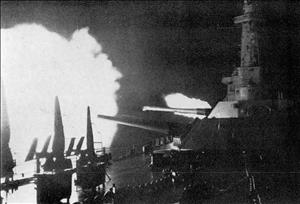On November 15, 1942, the USS Washington (BB-56) sinks the Japanese battleship Kirishima in the Second Naval Battle of Guadalcanal in the Solomon Islands, the first head-to-head confrontation of battleships in the Pacific war. The decisive action blunts a Japanese counterattack against the U.S. invasion of Guadalcanal. The Washington will serve throughout World War II.
The USS Washington (U.S. Navy capital ships were named after states) was launched in 1940 and christened by Virginia Marshal of Spokane. The ship's mascot was the cougar and the newspaper was called the The Cougar Scream. In early 1942, the ship and her crew served in the North Atlantic and escorted convoys to Russia.
U.S. Marines landed on the island of Guadalcanal in August 1942 to seize an airfield under construction and to stop the Japanese advance towards Australia. The Imperial Japanese Navy launched a number of attacks against the Marines and against U.S. Naval forces supporting the landings. On the night of November 14-15, 1942, Task Force 64, consisting of the Washington and the USS South Dakota (BB-57) plus supporting destroyers, encountered the Japanese force assembled around the Kirishima.
The Washington was a modern North Carolina-class battleship armed with nine 16-inch guns. Using radar, the U.S. ship engaged the enemy just after midnight. The South Dakota was damaged, but the Washington sank a destroyer and fatally hit the Kirishima, which was scuttled by her crew a few hours later. The action was variously called the Second Naval Battle of Guadalcanal and the Third Battle of Savo Island. The Japanese did not seriously threaten Guadalcanal again.
Since the Age of Sail, battleships had fought one another for dominance of the seas, but the use of aircraft in warfare quickly rendered such encounters anachronistic. The naval actions in the Solomon Islands happened at night when aircraft were of little use.
The Washington served throughout World War II. After victory, she was mothballed at the Puget Sound Naval Shipyard in Bremerton. In 1960, she was scrapped. The ship's bell, the wheel, and some tompions (protective covers for gun barrels) were placed on display in Bremerton.

